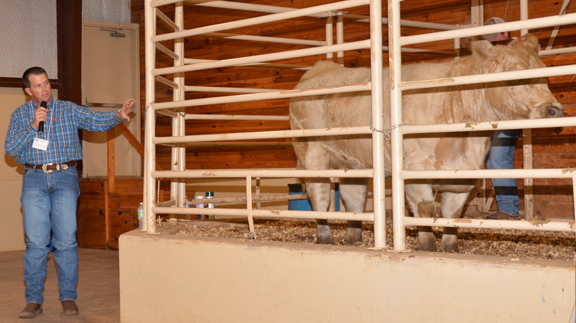Farm & Ranch
Think outside the box when selecting replacement cattle

By: Blair Fannin
Writer: Blair Fannin, 979-845-2259, [email protected]
BRENHAM – With cattle prices at record highs, ranchers looking to build back beef cattle herds need to take careful consideration of the composition of replacement heifers to yield top-quality calves, according to experts.
About 200 cattle producers attended the recent 43rd South Central Texas Cow-Calf Clinic in Brenham, hearing from a variety of experts. The event was hosted by the Texas A&M AgriLife Extension Service with support of beef and forage committees from Austin, Brazos, Burleson, Fayette, Grimes, Harris, Lee, Waller and Washington counties.
“This year we focused on heifers and took the opportunity to talk about the basics of genetics, selection, function, design, (and) utility,” said Kara Matheney, AgriLife Extension agent for Washington County. “We are at a unique time right now, where we are making some serious decisions about the quality of stock we are purchasing to restock or what we are raising as replacements.”
Doug Pierce, division chair for agriculture at Blinn College in Brenham, said cattle producers should look at a number of criteria when selecting good replacement heifers. Skeletal soundness and length of stride are among those to consider. He also said to observe things not commonly thought of.
“Look for weird things, such as width of mouth,” he said. “A wide-mouth cow will eat more and perform better. Good traits of a cow also include having a good body. She should also be a cow that cares for and can nurse her calf until weaning. I tell my students if it (the cow) can’t pay that rent check, she’s a freeloader and get rid of her.”
Dr. Jason Cleere said structure is important, and don’t select females that are post-legged or stand too straight up and down.
“Cattle that are straight, their joints start to wear out sooner,” he said. “That is a trait you do not want.”
Both Cleere and Pierce said to watch a cow’s stride. Cows that take shorter strides require more steps and can have reduced longevity. Width of pin bones is another thing to consider. Cows that are wide between their pin bones tend to have more calving ease than those with narrow openings, Cleere said.
-30-
Farm & Ranch
Hazards of Backyard Poultry

By Barry Whitworth, DVM
Having backyard poultry is a popular agriculture enterprise. According to the United States Department of Agriculture, 0.8 percent of all households in the United States have chickens. People keep chickens for a variety of reasons with table eggs being one of the more common reasons.
Unfortunately, some of these poultry producers are not aware of the hazards that come with keeping poultry because many times they carry pathogens but appear healthy.
Chickens are carriers of several zoonotic diseases. These are diseases that can be passed from animals to humans. According to a recent survey in Pennsylvania, a majority of backyard poultry producers were aware of the dangers of avian influenza. However, this study also revealed that far fewer producers were aware of the risk of possible exposure to Salmonella and Campylobacter.
The lack of knowledge about the hazards of raising poultry likely contributes to the continued issues of Salmonella outbreaks associated with backyard poultry. In 2023, the Centers for Disease Control and Prevention reported 1,072 illnesses of Salmonella linked to backyard poultry, and 272 of those patients required hospitalization. Oklahoma reported 43 individuals with the disease.
To read more, pick up a copy of the April issue of NTFR magazine. To subscribe by mail, call 940-872-5922.
Farm & Ranch
Ag Elsewhere: Wyoming

By Tressa Lawrence
Babies are tucked away in every nook and cranny. Many ranchers across Wyoming have baby animals popping up all over this time of year.
Farm & Ranch
Ag Elsewhere: Montana

By Lindsey Monk
Another load of grain in to keep feeding the calves until the green grass can really start popping.
-

 Country Lifestyles1 year ago
Country Lifestyles1 year agoScott & Stacey Schumacher: A Growth Mindset
-

 Equine7 months ago
Equine7 months agoThe Will to Win
-

 Country Lifestyles7 years ago
Country Lifestyles7 years agoStyle Your Profile – What your style cowboy hat says about you and new trends in 2017
-

 Country Lifestyles4 years ago
Country Lifestyles4 years agoAmber Crawford, Breakaway Roper
-

 HOME7 years ago
HOME7 years agoGrazing North Texas – Wilman Lovegrass
-

 Country Lifestyles7 years ago
Country Lifestyles7 years agoDecember 2016 Profile, Rusty Riddle – The Riddle Way
-

 Country Lifestyles8 years ago
Country Lifestyles8 years agoJune 2016 Profile – The man behind the mic: Bob Tallman
-

 Outdoor9 years ago
Outdoor9 years agoButtercup or Primrose?






